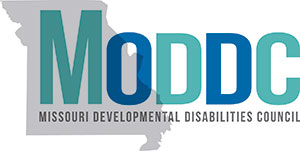Missouri Developmental Disabilities Council's Position Creating a Culture of Coordinated Support
People with intellectual and developmental disabilities (I/DD) get services from many different groups. When these groups work together, it gets easier to give better care. People with I/DD deserve the best support possible. So, groups that work with people with I/DD should always work together. When groups work together to help someone with a disability, it’s called coordinated support. Coordinated support is very important to help disabled people live good lives.
Why is coordinated support important?
Groups that help disabled people don’t always work together. When they don’t work together, they get in each other’s way. They miss out on opportunities to help people. They waste time, energy, and money. When groups don’t work together, this is called a silo system.
All of this makes it harder for people to get the help they need. Sometimes it means they can’t get the help they need at all.
Missouri should make sure service providers work together. This is called making a Culture of Coordinated Support (CCS).
In CCS, groups look at what help a person needs. Then they talk to each other. They make sure all their goals make sense. They figure out which groups can do the best job with each need. This way, people can get the best help possible from them.
Here’s an example.
Mandy is a person with I/DD. She gets help from an inclusive education program. She also gets help from a Vocational Rehabilitation agency, and Medicaid. All three groups are supposed to help with school, work, and housing.
In a silo system, each group works alone to help with each of these things. They would all have their own goals and plans for Mandy. Instead of focusing on learning, Mandy’s school would also have their own goals for Mandy’s work and housing. This means Mandy’s school spends less time helping Mandy learn. They might teach Mandy things that she already knows, or doesn’t need to know.
In a CCS system, the groups talk to each other. They figure out everything Mandy needs. They figure out which groups can do the best job helping Mandy with each thing.
Mandy’s school focuses on learning. Vocational Rehabilitation focuses on helping her with work. And Medicaid focuses on helping Mandy get a place to live.
This can only happen if the groups work together. They talk to each other so they know which groups are doing which things.
People have tried CCS programs in many places. One is the Successful Transitions Project in Fair Haven Vermont. A high school, a Vocational Rehabilitation agency, and a Medicaid Waiver provider started working together. After a year, they asked students, parents, teachers, and counselors what they thought. Everyone said that supports were better when groups worked together.
What should Missouri do?
- When Missouri agencies help someone with disabilities, they should work together. People with disabilities should get good help that they can rely on. They should be in charge of the help they get.
- When helping someone, groups should try not to get in each other’s way. They should avoid doing the same things twice. Agencies should have clear goals for the people they help.
- The law says that certain groups have to work together. Inclusive Education groups and Vocational Rehabilitation agencies are one example. These groups should agree on rules to follow when they work together. These rules can help them give the best support possible.
- Missouri should make a CCS Task Force. The Task Force should be run by people with I/DD. It should also have people from state agencies, like Vocational Rehabilitation. The task force should help all the different groups learn to work together.
- Missouri should talk to other states and groups that have already started doing CCS. Missouri can learn from other states’ projects.
To Learn More
Gustin, J. & Martinis, J. (2016). Change the Culture, Change the World: Increasing Independence by Creating a Culture of Coordinated Support. Apostrophe Magazine. Available at: www.apostrophemagazine.com
Katsiyannis, A., deFur, S., & Conderman, G. (1998). Transition services: Systems Change for Youth with Disabilities? Journal of Special Education, 32(1), 55-61.
Gustin & Martinis, 2016; Martinis, J. & Blanck, P. (2019). Supported Decision-Making: From Justice for Jenny to Justice for All. A Theory to Practice Guide. Virginia: Something Else Solutions Press
Blanck, P. & Martinis, J. (2015). The Right to Make Choices: The National Resource Center for Supported Decision-Making. Inclusion, 3(1), 24-33.
Martinis, J. & Gustin, J. (2017). Supported Decision-Making as an Alternative to Overbroad and Undue Guardianship. The Advocate, 60(6), 41-46. Martinis & Blanck, 2019.
USC 1401(34) (required Special Education Transition services); 34 C.F.R. 361.48 (required Vocational Rehabilitation services); www.medicaid.gov/medicaid-chip-program-information/by-topics/long-term-services-and-supports/home-and-community-based-services/downloads/1915c-fact-sheet.pdf (required Person Centered Planning services)
Martinis & Blanck, 2019.
Martinis, J., Cassidy, K., Gustin, J., Nadeau, J., & Robinson, D. (2019). Creating a culture of coordinated support: The successful transitions program. Impact 32(1), 19-21
20 USC § 1401(34) (Special Education Transition services must be "coordinated" and include vocational education and services); 34 C.F.R. § 361.22 (Vocational Rehabilitation agencies must coordinate with schools).
States and communities that have implemented Culture of Coordinated Support-based systems include Vermont (statewide Task Force); Tennessee (collaboration between state agencies, led by Developmental Disabilities Council); Fair Haven, Vermont (community based project); and Pickaway
PDF Downloads
[English] MODDC Creating a Culture of Coordinated Support Position Statement July 2022
[Spanish] MODDC Crear una cultura de apoyo coordinado Julio de 2022
[English] MODDC Culture of Coordinated Support Statement - Plain Language 2023
(Spanish) MODDC Crear una cultura de apoyo coordinado lenguaje simple

